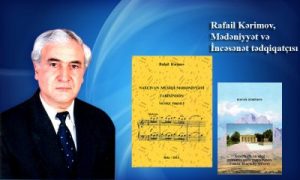Music World of Phonemes

The ancient Nakhchivan which is considered to be the starting point of the modern civilization in the world, and known as the territory where the Prophet Noah had settled, during centuries has granted to Azerbaijan and the world hundreds of well-known thinker-scientists, architects, men of science and culture, ashug masters, singers, writers and poets, eminent political and state figures. This process is continuing at present time as well…
Before going over the subject I would like to express my profound respect and consideration for late Fikrat Rzayev, a man who immersed me in magic world of “Word”s, if to say by words of the professor Buludkhan Khalilov, good intelligent who “…did not have any title in the world of science, and did not feel need in it, lived in his spiritual world…”, who brought great novelties in linguistics with his research works, even if he was not a linguist, who analyzed role of phonemes in disclosure of meaning of words by means of mathematical, physical regularities, and fully expressed dependence of the meaning on phonemes.
The arguments, directions, parameters on role of phonemes in disclosing of the meaning of word talked about, indicated in “Word. Word Construction. Secret of Word” monograph by F.Rzayev are very valuable and new propositions in scientific point of view. I am sure that in near future a lot of work will be done in this direction, and our linguist-scientists will assess once again dependence of the meaning of words on phonemes from this point of view basing on F.Rzayev’s theses.
…Making some researches in music science as in other spheres, I would like to take first steps clarifying dependence on phonemes of the meaning of mugham considered as the fundament of our music science, especially meaning of some of the 7 main concords used in Azerbaijan basing on F.Rzayev’s theory.
There have been written very valuable works on mugham starting from al-Farabi (865-950) down to the being time, mughams had been systematized, divided on sections-divisions, and analyzed. But the meanings of “mugham” word and of the names of 7 main concords were not interpreted by indicated method… From this point of view, interpretation of the meanings of these words basing on mentioned methodology, I think, will bring new shades to the words used during centuries.
Mugham [mugham]
As is clear from the writing, the word [mugham] consists of 5 letters (phonemes). Here the /M/ phoneme: expresses the feature of relation, correspondence, analogy between events, and conduction of job by means of something (by somebody). These features proved to be completely correct in the word mugham. Thus, there is no need in proof for relation, correspondence between sections and divisions of mugham. Really, in some mughams the “Shikasteyi-fars” section is plaid and sung in accordance with “segah” concord, but has temporary character and the end of the section is completed with the main concord moment. Therefore, common correspondence, relation is never lost or violated in mugham. As concerns the feature of conduction of the job by means of something, this is obvious here too. Mugham is performed, in other words, the job is done by saz players and singers.
The /U/ phoneme – features greatness, being long-time, start of event from one point, from one place, its advancement and then completion, ending having returned to the same point again, and this feature is a common feature which is peculiar to all of our mughams. Old, very ancient history of mughams, their entrance from “Bardasht” section starting from “Maye” section, advancement up to culmination point, return to “Maye” section and completion of mugham in this point fully expresses the meaning of the /U/ phoneme.
The /Gh/ phoneme – the feature of events to undergo change when moving from one environment to another (in mughams from section to section or division) is also fully expressed in mugham. In mughams performance of every division and section in different character: raging, mournfully, lamentably, in solemn manner and etc. is indication of change of character of events when moving from one environment to another (to sections and divisions).
The /A/ phoneme – expressing the feature of science, knowledge, Divinity, voice indicates identity of these features with values revealed during research of mughams up to the present time.
As is known from music treatise of Darvish Ali, the music theorist of the XVII century, “Rast” considered to be the most ancient mugham “came to us since the Prophet Adam’s epoch, and expresses moan of the first human deposed from everything about Paradise”.
Therefore, the notions of greatness, Divine power, voice directed (sent) by God expressed by /a/ phoneme fully come true in this phrase of the prominent musicologist and theorist Darvish Ali. And the voice feature does not need any proof. As in Azerbaijan mugham has been performed by singers with great talent since very ancient times and is performed now. And beautiful voice is always called “God’s gift”… One opinion is also justified here that it is wrong when the countries not having singers pretend to something in mugham proficiency, and it would be more reasonable if they dealt with instrumental performance of mugham.
I think, taking into account above mentioned, when interpreting the meaning of the word “mugham”, by all means we have to form an idea expressing the facts such as greatness, science, course of events (by character), start of performance from one point and return to the same point and etc., and have to give interpretation of the word “mugham” expressing this meaning.
Rast
The “Rast” mugham, as we see, consists of 4 phonemes. If to express by F.Rzayev’s methodology, in the indicated word the /R/ phoneme expresses the meaning of place, geographic place, space, the /a/ phoneme – science, knowledge, Divinity, voice, the /s/ phoneme – light (radiance), sense, sound, creating, and the /t/ phoneme – the meaning of remote influence. If to pay attention to opinions expressed in different periods by prominent musicologists, theorists about “Rast” mugham, we would notice that the features of the phonemes forming this mugham name coincide very precisely with those opinions. For example: if to remember the words of the prominent musicologist Darvish Ali about “Rast”, and the features of the /a/ phoneme, when analyzing the features of the phonemes in the word “mugham”, we would witness justification of this opinion in the “Rast” mugham (see: the part about mugham). If to add the features of the “r” phoneme we will see how harmonious sound the features of just these two phonemes with the space, geographic place, science, knowledge, sound features of “Rast” mugham. As concerns the features of the /s/ and /t/ phonemes, I would like to conclude it with Uzeyir Hajibeyli’s (great composer of Azerbaijan) sentence about “Rast”. Uzeyir Hajibeyli considering the “Rast” to be the music nourishing mind wrote that: “Rast” is a valuable composition disposing to integrity, honesty and sacred nobility. I think that “Rast” is a music nourishing not sense but mind”. I think, this opinion is example of the most valuable expression of the mind, radiance features of the /s/ phoneme and the remote influence feature of the /t/ phoneme.
We all know very well how mughams touch our feelings and immerse us in thoughts. As concerns the thoughts provoked by “Rast” mugham and its sections and divisions, it would be more reasonable if to say it by words of the outstanding master of mugham Kamil Ahmadov: “The Rast composition indicates propagation of an old, wise, experienced grand, the history, struggle of our nation”. Courage, bravery of our nation is expressed here. Just these propositions stated by the prominent musicologists reaffirm that the meaning of the name of “Rast” completely matches the features of the phonemes that form it.
Shur
As we see the name of “Shur” [ʃur] composition consists of three phonemes. We have already given detailed information about the features of the /u/ and /r/ phonemes interpreting the meanings of the words “Migham” and “Rast” that we researched in the beginning of this article. As concerns the feature of the /ʃ/ phoneme, its features are completely justified in this mugham too. Thus, the feature of creating inside doubleness, multiplicity concerned to this phoneme is expressed more vividly in “Shur” mugham. Small sized mughams such as “Abu-ata”, “Dashti”, “Bayati-Kurd”, “Shahnaz” which are on the basis of ”Shur” concord-moment, and three of existing 10 blast mughams: “Samayi-shams”, “Mani”, “Arazbari” being on “Shur” concord-moment are obvious examples of presence of the feature of creating multiplicity in this mugham.
Of course, I will give necessary information about our other concord-moments in my next articles. But before that I would like to know the readers’ opinions about this article.
It is known that the first “steps” are always weak and attract ambiguous eyes. Therefore, the article may cause some disputes. But as it is said “An idea appears from idea”. And I also want to hear not disputes but just new views from our music community.
Rafail Karimov,
Honoured Art Worker of Autonomous Republic of Nakhchivan
Translated by Kamala Amiraslanova







